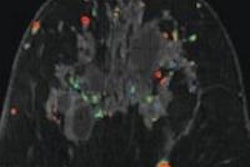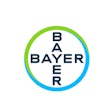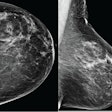Computer-aided detection (CAD) firm Riverain Technologies' CAD software can detect subtle lung cancers and lead to an earlier diagnosis by an average of 18 months, according to research presented at RSNA 2013 in Chicago.
In the retrospective study, Riverain's ClearRead +Detect was applied to 66 chest x-ray images of patients whose ages ranged from 44 to 91 years old. The lung cancers were present but missed on the initial chest x-ray image. Most of the cancers were classified as subtle (mean 2.39 on a scale of 1 to 10, with 1 being very subtle) and thus difficult to detect.
ClearRead +Detect identified 56% (37) of the missed lung cancers, demonstrating the potential for more than one-and-a-half years (577 days) earlier detection when the chest x-ray images are augmented with the software markings.
The software marks suspicious regions on a conventional chest x-ray image so radiologists can further evaluate the areas and embeds Riverain's bone suppression technology, which suppresses the clavicle and ribs that often obscure potentially cancerous lung nodules. There is no additional radiation exposure to patients and no additional equipment, space, or staffing requirements for healthcare facilities, Riverain said.
"The performance of the software at detecting early, subtle lung cancers was really good and the false-positive rate was very low -- less than one per procedure," said Dr. Chip Gilkeson, a professor of radiology and the vice chairman for clinical research at University Hospitals Case Medical Center/Case Western Reserve University.
The software could detect unsuspected lung cancers in routine x-rays, such as those taken for chest pain or before surgery, and in patients who are nonsmokers, light smokers, or otherwise wouldn't qualify for lung cancer screening, Gilkeson said.
Another study published in the December 2013 issue of the European Journal of Radiology (Vol. 82:12, pp. 2399-2405) found that Riverain's standalone bone suppression software without CAD markings, ClearRead Bone Suppression also significantly improved the detection of lung nodules in chest x-ray images.
Radiologists at the Radboud University Nijmegen Medical Centre and the Meander Medical Centre in Amersfoort, the Netherlands, missed 26% fewer lung nodules using ClearRead Bone Suppression than they did when evaluating conventional x-ray images alone, Riverain said.



















